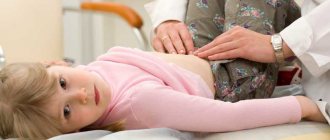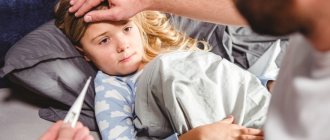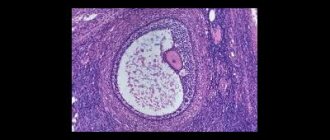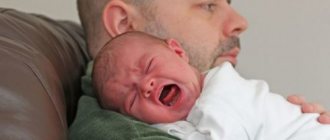Testicles are paired glands that produce sperm, sex hormones and other biological substances. The right one is normally located slightly higher than the left one, and is separated from it by a vertical partition. This circumstance explains why each of them can hurt on its own - the process is limited (at the beginning). All arteries supplying the organ are extensively connected by branches to each other (anastomose), and the outflow is carried out through the venous and lymphatic networks. The nature of pain may vary depending on the area of damage to these structures.
Causes of testicular pain in children
It should be remembered that pain in the testicles can affect even a newborn baby. But the causes of the pathology should be considered in more detail.
Injuries
One of the most likely factors of pain syndrome. Careless games, a fall, a direct blow to the groin area - all this can cause discomfort. For mild blows, you should let your child or teenager lie down, but if the pain does not go away within an adequate time, you should see a doctor. Otherwise, damage to the testicle threatens complete atrophy of the organ. If the injury is caused by a sharp object, you should consult a doctor immediately.
Testicular torsion
A pathology in which the testicle rotates in the scrotum around its axis. The process is complicated by the cessation of blood supply to the spermatic cord, and unbearable pain occurs. Torsion should be corrected as quickly as possible so that the process of necrosis does not begin. Most often, torsion of the spermatic cord occurs in children before puberty.
Important! Torsion of the pendulous testis occurs. The vestigial process, localized in the upper pole of the testicle, is also subject to torsion. In this case, the pain increases and is diagnosed only with ultrasound.
Epididymitis, orchiepididymitis
Inflammation of the appendage alone or together with inflammation of the testicle is the cause of acute pain. Diseases are caused by pathogenic or conditionally pathogenic bacteria. In adults there are many factors for the disease, in children - backflow of urine from a full bladder, hypothermia, injuries. Despite the fact that the disease is rare in childhood and adolescence, it should be remembered.
Cryptorchidism
The disease is called “hidden testicle”. An anomaly characterized by failure of the testicle to descend into the scrotum. Normally, both eggs descend into the scrotal sac up to 8 weeks of age, but sometimes the process is delayed for 6 months or more. The development of cryptorchidism occurs in 4% of full-term children and 30% of boys born prematurely.
Dropsy - hydrocele
A disease of congenital or acquired type, characterized by the accumulation of serous contents in one of the testicles. If a child’s testicles hurt and one of them is visually much larger, immediately consult a doctor. Dropsy after 3 years is an acquired disease, the cause of which can be: trauma, torsion, inflammatory processes and much more.
Important! Congenital hydrocele is a pathology associated with intrauterine development. It is diagnosed in 10% of cases and most often goes away without specialist intervention.
Varicocele
This disease is typical for adolescents during puberty. If in children under 10 years of age the probability of pathology is low and it is possible to obtain stage I varicocele, then young men from 14 years of age can receive stage II-III of the disease, complicated by intractable infertility. The stages of pathology differ as follows:
- The first one can be observed if a 10-year-old boy has testicular pain, but without acute pain syndromes or attacks. During palpation, the vessels can be felt only in a vertical position of the body.
- The second is that the intensity of growth up to 14 years provokes the rapid development of pathology. If a teenager’s testicle hurts, the patient complains of a burning sensation, the asymmetry of the scrotum is visually noted, and veins are visible, you should consult a doctor.
- The third affects patients over 14 years of age. The scrotum already looks like a bunch of grapes, the veins hang freely. Varicocele at this stage of development has a high risk of onset of atrophy of the paired organ.
Development factors include: heredity, high blood pressure, tumors, congenital damage, trauma. The child should be taken to the doctor at the first symptoms, otherwise the varicocele will quickly develop into the final stage, which may result in male infertility.
Treatment methods
If a man has pain in his left testicle, this is a sign of a serious pathology. There are many causes of pain, but any of them requires the help of a urologist. Almost any pathology of the left testicle is accompanied by severe pain, so if discomfort occurs, it is necessary to immediately solve this problem.
The left testicle in men is located slightly lower than the right one - this is not a pathology, but a physiological feature of the structure of the genital organs. In this regard, it is the left egg that is more often exposed to physical impacts, injuries and bruises.
There are not just many reasons for swelling, but they are individual for each man. Diseases occur in the scrotum, often accompanied by severe pain; the left testicle may also become swollen due to diseases of the appendages, testes, and spermatic cords. All these components inside the scrotum are interconnected and are susceptible to various diseases.
Tumors can occur for the following reasons:
- Due to the formation of a hernia in the scrotum.
- Due to the development of the inflammatory process on the epididymis
- Due to torsion of the testicles.
- Due to the development of a disease such as dropsy.
We invite you to read: How to treat erectile dysfunction with Super Levitra
The reasons you listed are most common in medical practice.
However, there are other factors that influence the appearance of pain in the left testicle:
- Pain in men can occur due to a blow to the left testicle or injury to it.
- The testicle may become inflamed due to some kind of infection.
- Strong compression can cause pain in the scrotum on the left; tight and tight swimming trunks can provide this compression.
- In winter, pain can occur from severe hypothermia.
- A man's testicle may become swollen and painful due to lack of regular sexual activity.
- A cyst may develop in the spermatic cord and cause pain.
- The pain occurs due to the development of varicose veins located in the man’s scrotum.
- Due to an injury to the tailbone or spine in the lumbar region, nerve conduction may be disrupted and pain in the scrotum may be a reflection of these injuries.
If pain appears in the left testicle, this may be due to the occurrence of an inguinal-scrotal hernia, which, in turn, was formed due to weakened muscles in the groin area.
The muscles in the groin weaken for a number of reasons: this can happen when lifting heavy objects, or if the patient often strains during bowel movements, suffering from constipation.
Weak groin muscles can be inherited at the genetic level.
Any of these reasons causes increased pressure, which affects the abdominal cavity; frequent increases in such pressure lead to the hernia descending through the inguinal canal into the scrotum. Men who are overweight or have frequent constipation are at risk of acquiring such a hernia. If a scrotal hernia occurs, you may experience blue discoloration of the scrotum, severe pain and swelling in the groin area.
Inflammation of the epididymis is one of the causes of pain in the scrotum on the left. This disease is called epididymitis. It occurs against the background of private or chronic infectious diseases. These infections can cause consequences such as vesiculitis or prostatitis. If treatment of the infection is delayed, the scrotum and testicle may become swollen and red.
Epididymitis has its own symptoms, which are easily recognized by doctors. This is swelling and compaction on the scrotum: it increases and becomes painful. Sometimes, of course, the pathology occurs without showing any symptoms, which is more dangerous for health.
The advanced form of epididymitis leads to the following consequences:
- Sexual function disorder.
- Pain appears when semen is released.
- The appearance of blood in the discharge is often observed.
- A man develops orchitis.
- The left testicle is enlarged.
- The man's temperature rises, weakness and headache are recorded.
- Pus appears in the left testicle.
If this disease is not treated, it will end in infertility.
With strong physical activity of a man, a pathology called torsion is possible. This leads to testicular swelling and severe pain. This effect can be caused not only by physical activity, but also simply by sudden movement or injury. The testicle may not descend properly into the scrotum after being raised.
When the testicle is twisted, the blood vessels in the scrotum are pinched and injured, and the spermatic cord is injured. The scrotum swells and swells, the testicle hurts so much that the man feels sick and vomits from the attacks of pain.
Mild torsion can be easily treated by a doctor. In severe cases, only surgery can help the patient. If the patient is not helped in time, the reproductive cells stop being produced, and infertility occurs.
Hydrocele is caused by the accumulation of fluid around the testicle. Dropsy occurs slowly and, as a rule, begins in one testicle. The tumor comes and goes, that is, in the morning, for example, the swelling around the testicle disappears.
The man, as usual, does not pay attention to the fact that his testicle sometimes ache. This is the danger of this disease. Since the symptom is barely noticeable pain and almost imperceptible swelling, treatment of the pathology begins too late, when the disease is already advanced.
In severe form, there is fever and severe pain.
Dropsy is also caused by certain infections or injuries. Diagnosed by careful palpation. Dropsy is treated comprehensively, that is, in addition to surgically removing the fluid, the patient is given a strong antibiotic that fights inflammation. If dropsy is not treated, it will also lead to infertility.
A painful sensation in the left testicle may occur due to prostatitis. This phenomenon is quite common. Acute prostatitis develops due to bacteria entering the prostate gland. In this case, the following symptoms are observed:
- Body temperature rises.
- Chills and general tremor appear.
- The pain is very widespread: from the abdomen to the testicles, sometimes even extends into the left leg.
- The pain does not allow the man to relieve himself normally.
- A man feels a constant burning sensation in the urethra.
During the chronic form of prostate disease, symptoms are usually not observed. Prostatitis is treated with antibacterial agents and, if necessary, painkillers.
It’s rare that just pain or just swelling can force a man to immediately consult a urologist. This is the wrong position. To maintain health and sexual function, you should consult a doctor with any suspicious symptom, especially if there are several of them. Here are a number of symptoms that may cause an immediate visit to the doctor:
- Pain occurs when touching the genital organ.
- The left testicle has noticeably increased in size.
- The scrotum changed its shape and became more rounded.
- The left appendage became denser and harder to the touch.
- The pain came suddenly, as if from a blow, but there was no blow itself.
- If the pain spreads to the entire scrotum.
- If the pain is accompanied by vomiting and fever.
- If after a scrotal injury the pain does not go away in the shadow of an hour.
If several of the listed symptoms occur at once, then even more so you should immediately go to a urologist.
Remember that timely treatment will help avoid serious consequences, and the therapy itself in the initial stages of the disease will not take much time and money.
There are several ways to diagnose diseases. But the doctor decides which method to use based on the information received from the patient about the cause of the pain and tumor.
For example, for a hernia, ultrasound examination of the scrotum or contrast radiography of the scrotum is used. These methods allow you to determine the exact location of the hernia.
A blood and urine test is done to determine inflammatory processes in the scrotum. In this situation, it is necessary to determine the cause of the inflammatory process, that is, the type of infection is determined. If the tests do not give a clear answer, then an ultrasound examination of the scrotum is also performed.
Ultrasound examination and palpation help determine testicular torsion or hydrocele. In any case, treatment will not begin without an accurate diagnosis, even if it is necessary to use all available diagnostic methods to determine it (including such a little-known method as diaphanoscopy, which determines the serous fluid in dropsy).
And only after identifying the cause of the pain and testicular tumor, treatment begins. Treatment is carried out only by a urologist. It is impossible to draw hasty conclusions; self-medication in this case is impossible and even dangerous to health. Moreover, most of these diseases are treated only in hospitals and only surgically.
Whatever the reasons for the disease of the left testicle, remember the main thing: it is his testicles that make a man a man. If you monitor your health and consult a doctor at the first symptoms, you will maintain your masculinity and fertility for many years.
We suggest you read: Is it possible to do prostate massage yourself?
The testes are responsible for the production of testosterone and sperm synthesis in men. Otherwise they are called testicles or testicles. These paired organs are located inside the scrotum. When faced with the question of why the right or left testicle hurts, urologists look for causes in men in disorders of a traumatic or inflammatory nature, as well as in anatomical anomalies.
Not only adult men complain of pain in the left testicle. Unpleasant sensations in the groin area can occur in a teenage boy and even in a child who has barely learned to walk. In addition to the piercing unbearable pain, the man experiences fear for his life. There are frequent attacks of nausea, vomiting, profuse sweating, and loss of strength.
Pain in the testicles is caused by various pathologies. There are so many of them that it is impossible to independently determine the cause of the ailment. Only a urologist or andrologist can cope with this task.
Diseases that cause pain in the testicles in men include
- chronic form of prostatitis;
- epididymitis;
- orchitis (testicular inflammation);
- diseases that are transmitted through sexual contact;
- too low or high temperatures;
- groin injuries;
- impaired blood supply to the testicle due to twisting of the spermatic cord;
- varicose veins of the testis;
- spermatocele (testicular cyst);
- hydrocele (dropsy);
- inguinal hernia;
- malignant and benign neoplasms;
- pain during prolonged abstinence.
If you start treatment in a timely manner, you can quickly get rid of pathologies. But with chronic pain in men in the lower abdomen, the unpleasant sensations do not disappear even after a course of therapy. And in a quarter of all cases, the cause of the pain remains unclear.
- For example, testosterone, as well as sperm.
- A man’s health and his reproductive function largely depend on the condition of the genital organs.
- Due to high sensitivity, damage or inflammation in this organ causes severe pain.
- In men, the testicles are located in the scrotum; it is into this that they descend at the time of the birth of a boy.
Causes of pain
Disease symptoms and diagnosis
Symptoms will help you find out why a boy’s testicle hurts, the reasons and factors. When to see a doctor:
- pain syndrome of a pulling, sharp or cutting nature, lasting more than 20-25 minutes;
- sharp or intensely increasing pain;
- increased body temperature;
- change in color of the skin of the scrotum, testicle;
- increase in the size of the scrotum;
- hardening of the testicles, compactions, tumors detected by palpation or visible visually, as well as inflamed (enlarged veins);
- itching, burning in the groin area - especially important if the teenager began sexual activity early and had unprotected contact;
- general signs of intoxication (nausea, vomiting), accompanied by pain in the groin, abdominal area, lower back;
- testicular pain when palpated;
- enlarged inguinal lymph nodes;
- heaviness in the scrotum;
- palpation determines the tumor, regardless of the presence or absence of pain;
- Local lymph nodes are enlarged and the pain radiates to the lower back.
In the presence of an inflammatory process, as a rule, the child’s right testicle hurts - this is due to the anatomy of the structure of the organ. Dropsy will make itself felt with a characteristic sign: swelling and subsidence of the tumor several times during the day. In this case, the tumor can develop rapidly - literally in an hour the testicle swells to serious sizes. Fever, chills, fever, redness of the skin are additional symptoms that are also worth paying attention to.
To find out why a child’s testicle hurts, the doctor will examine the patient rectally, palpate the scrotum, and prescribe:
- collection of urine and blood tests;
- examination of prostate secretions;
- bacteriological diagnostics;
- PCR;
- Ultrasound;
- coprogram;
- microscopy of a smear from the urethra.
All studies are prescribed depending on the type of pathology, symptoms and individual characteristics of the child. Ultrasound is one of the most informative options for a safe and painless examination, so it can be prescribed many times. This should not be feared; through ultrasound, the doctor can more accurately determine why the testicle is larger/smaller, how severely developed the pathology is, assesses the condition of the internal structure of the testicle, and so on. If there is severe pain, for example with torsion, the examination is carried out using a light local anesthetic.
Why does a child's testicle hurt?
- Features of the organ or what to pay attention to
- Injuries
- Testicular torsion
- Epididymitis - inflammation of the epididymis
- Orchitis – inflammation of testicular tissue
- Varicocele - dilation of the veins of the spermatic cord and testicles
- Hydrocele - dropsy of the testicles
- Symptoms
- Cryptorchidism - “hidden testicle”
- Testicular tumor – oncology
Any parents are well aware of the main childhood diseases, their symptoms and first aid. But the question of why a child’s testicle hurts can confuse many. In fact, there can be many reasons for this condition. And most of them carry a risk to the life and future health of the child. Therefore, if there is any pain in the area of the testicles, the boy should be immediately shown to a doctor.
Any deviations in the reproductive system are usually considered as age-related. It is assumed that children are protected from them, because active play and puberty are still far away. But age does not protect against problems. Pain can occur at any time, even in an infant.
Features of the organ or what to pay attention to
The testicles are paired sex glands. Their function is both to produce testosterone (male sex hormone) and to produce sperm. Therefore, they are usually classified as glands of both internal and external secretion.
Due to the particularly important role that testicles play in a man’s body, any disease can lead to a number of undesirable consequences - from impotence to infertility or disability.
What you need to pay attention to if your child complains of pain:
- In their shape, the testicles really resemble an egg, with its sharp end pointing upward. Any change in position should alert you. Normally, palpation is painless.
- The left testicle is always lowered slightly lower than the right one. Visually, they may also appear different in size. It is not normal for the diseased testicle to be significantly larger than the other.
- The temperature is always lowered, this is necessary to preserve the vital activity of sperm. A hot scrotum, especially at the site of pain, is a cause for concern.
Injuries are the most common cause of testicular pain in children.
Our readers recommend
Our regular reader got rid of PROSTATITIS using an effective method. He tested it on himself - the result was 100% - complete relief from prostatitis. This is a natural remedy based on honey. We tested the method and decided to recommend it to you. The result is fast.
EFFECTIVE METHOD.
According to statistics, even after successful therapy, in 25% of cases the pain can become chronic, and the testicle can hurt from time to time throughout life. Therefore, if a child complains, you should not postpone a visit to the doctor.
Epididymitis - inflammation of the epididymis
Contrary to popular belief, this disease is not limited to adult men. Causes of epididymitis in children:
- In almost 80% of cases, the infection is bacterial in nature. The causative agent in this case is intestinal bacteria.
- Microbacteria and fungi are another possible, but extremely rare cause of inflammation.
- Complications after viral diseases (flu, chickenpox) are more typical for boys of early preschool age.
- The dosage form occurs as the body's response to certain medications.
- Hypothermia of the pelvic area.
- Trauma – mechanical damage or damage resulting from surgery.
In children, the acute form of the disease most often occurs. It manifests itself with very sharp pain in the testicular area. May radiate to the groin, sacrum or abdomen. It develops very quickly and reaches a peak within the first day.
The most striking symptoms include:
- Significant enlargement of the diseased testicle - 2 times or more in just a few hours.
- The testicle is painful to the touch. Seals are also identified.
- The occurrence of fever, attacks of nausea, an increase in body temperature up to 40 degrees.
- Urination is painful, the frequency of urge increases, and blood may be present.
- Any movement increases the pain.
- The inguinal lymph nodes are significantly enlarged.
Epididymitis
Acute symptoms may go away on their own within a couple of days. If inflammation is not treated, it becomes chronic. Most likely leads to male sexual impotence, possibly blood poisoning or testicular necrosis. If you consult a doctor in a timely manner, the prognosis is favorable.
Orchitis – inflammation of testicular tissue
It is not for nothing that many parents of boys are afraid of mumps, without even knowing the reason. And the reason is that orchitis very often develops as a result of mumps. Inflammation can also develop as a result of common common diseases:
- Flu.
- ARVI.
- Inflammation is mild.
- Infectious and inflammatory diseases of the reproductive system.
Very often, orchitis occurs against a background of weakened immunity. It should also be noted that there is a risk of inflammation as a result of injury.
Orchitis can have acute and chronic forms. But in any form, the main symptom is the same - the boy’s testicle hurts. They differ only in the intensity of symptoms. The general symptoms are quite characteristic:
Increased body temperature
- Pain and enlargement of the testicle.
- Redness and swelling of the scrotum.
- Nausea, headache, increased body temperature.
Be sure to consult a doctor to receive qualified medical care. Otherwise, this disease may develop complications - epididymitis, purulent melting of the testicle, atrophy and infertility.
Varicocele - dilation of the veins of the spermatic cord and testicles
This disease is typical for young people at the end of puberty. In boys under 10 years of age, the incidence of cases is low - about 7% and only the first stage of the disease develops. In adolescents from 14 years of age, both the second and third degrees of development of the disease can be observed. A complication resulting from the disease is intractable infertility.
The disease has 3 stages:
- 1st, easiest stage. It is observed in boys under 10 years of age. There are no disturbing symptoms, no pain. Dilated vessels can only be felt in a standing position.
- 2nd stage. It occurs during a period of intensive growth - about 14 years. At 10 years old it is rare. The child complains of pain in the scrotum area, and a burning sensation may occur. At a glance, veins extending below the testicle are visible. The scrotum itself is asymmetrical.
- 3rd stage. Typical for boys over 14 years of age. The function of spermatogenesis is impaired. The testicles are small and soft. The scrotum is grape-shaped due to freely hanging veins. There is a high risk of atrophy.
The stages of the disease can appear at different ages. Much depends on the child’s hormonal background, the onset and development of puberty.
Varicocele
There are many factors influencing the development of the disease. Among the most common are:
- Heredity – weak vascular walls.
- Congenital damage and trauma.
- High pressure in the veins.
- Physical activity and weight lifting.
- Presence of a tumor.
Seeing a doctor is necessary at the first signs of illness. The most important thing is to prevent it from flowing into later stages. Symptoms are usually the following:
- Complaints of minor pain in the scrotum (both at rest and during physical activity).
- Itching or burning in the groin area.
- Increase in vein size.
- Enlargement of the scrotum.
After conducting all the necessary studies, the doctor may prescribe either medication or surgery. In any case, the prognosis for timely treatment is favorable.
Hydrocele - dropsy of the testicles
This is a congenital or acquired disease, which is characterized by the accumulation of serous fluid in the scrotum. Usually it is unilateral in nature, visually determined due to a significant increase in the size of the scrotum on the affected side. The number of cases of bilateral dropsy does not exceed 10%.
Possible risk factors: congenital anomaly associated with intrauterine development. It is diagnosed in the first period of life in approximately 10% of boys. In this case, it is classified as physiological. And most often it goes away on its own, without doctor intervention.
After 3 years of life, it is already customary to talk about an acquired disease. This can lead to:
- Injuries.
- Testicular torsion.
- Inflammation (orchitis, epididymitis).
- Tumors of the testicle and appendages.
- Postoperative complication.
As a complication after inflammatory diseases (ARVI, influenza), dropsy is quite rare.
Symptoms
With the inflammatory nature of dropsy, the child’s testicle hurts greatly. The main symptoms of inflammation are present: chills and fever.
In ordinary cases, dropsy practically does not make itself felt. It is diagnosed either by parents or by a doctor during a routine examination.
Hydrocele
The disease is characterized by enlargement of the scrotum on the affected side. Moreover, the increase can be temporary - decrease during the day, increase slowly or quickly. As the disease develops, the size on the affected side can increase to the size of a goose egg or a baby's head.
With timely diagnosis and treatment, the prognosis is favorable.
Cryptorchidism - “hidden testicle”
This is an anomaly of the development of the genital organs, characterized by the failure of one or both testicles to descend into the scrotum. Normally, both testicles should descend into the scrotum before the age of 2 months. Sometimes this process drags on for six months. This pathology is quite common. It occurs in approximately 4% of full-term boys and in almost 30% of premature babies.
Testicular descent begins around the 6th month of fetal development. In some cases, it can take the wrong direction and after the birth of the child, the testicle is found under the skin on the pubis, in the thigh area or in the perineum. The older the child, the less often this disease is diagnosed.
In only 3% of cases, one or both testicles are completely absent.
The causes of the disease usually include:
- Heredity. The presence of a similar problem in relatives increases the risk of the disease in descendants several times.
- Hormonal disorders during pregnancy.
- Infections during pregnancy.
- Multiple pregnancy.
- Taking certain medications during pregnancy (Paracetamol, Ibuprofen). When taken simultaneously, the risk of developing an anomaly in the fetus increases by more than 15 times.
- Harmful production.
If the testicle does not return to the scrotum on its own, surgery will be required.
Most often, the testicle will return to the scrotum on its own in the first months of the child’s life. Otherwise, surgery is necessary. Complications can be very different - from permanent microtrauma and testicular torsion to the development of oncology.
Treatment
After the reason why the boy’s testicles hurt is determined, the specialist will recommend the necessary therapeutic measures. If the bruise is not severe, the child should be allowed to lie down, a painkiller can be used, and cold applied for a short time (10-15 minutes) to the affected area. If the pain begins immediately and without visible signs of damage, you should immediately call an ambulance or go to the doctor yourself.
Inflammatory processes require a course of antibiotics, which are prescribed depending on the causative agent of the pathology. You should complete the course to the end, without stopping taking the pills after the symptoms disappear. After antibiotics, the patient is recommended to take medications to restore the microflora; physical therapy and herbal remedies help well.
Severe cases are resolved with surgery. The most dangerous thing is testicular cancer, in which it is necessary to remove the diseased organ in order to prevent the development of a tumor in another testicle. If surgical measures are insufficient, chemotherapy and radiation therapy are prescribed, and lymph nodes are removed.
Testicular torsion is a disease that needs to be treated immediately! An experienced specialist will quickly “unwind” the cord and prevent blood stagnation, necrosis and death of the organ. The pain during torsion is very strong, it is impossible to confuse the symptom, the boy will definitely complain about the sensations - it is up to the parents not to ignore the baby’s complaint.
Varicocele may not require treatment, especially if the pathology is congenital. The disease can cause infertility, so the specialist’s task is to assess the risk for the patient. In case of unbearable pain or negative spermogram abnormalities, a minimally invasive type of intervention is performed. The rehabilitation period is not long, the probability of full recovery is 98%.
Important! Treatment of pain in the scrotum is aimed not only at eliminating symptoms, but also at stopping the process that caused the symptom. Therefore, self-medication in this case is categorically unacceptable.
Prevention
Preventive measures include the following rules:
- Be examined once a year, regardless of the presence of symptoms of the disease;
- Teach your child to go to the toilet on time, not to endure it, not to do physical exercises with a full bladder;
- A child should not be embarrassed to tell his parents about pain in the genitals;
- Seasonal colds, flu, and diseases of the genitourinary system should be treated promptly and completely;
- Underwear must be strictly in size - tight panties often cause pathologies.
Pain in the left or right testicle: causes
A man may feel pain in both the left and right testicles, it can be mild or sharp and be accompanied by other symptoms. Among the reasons are:
- injury to the scrotum or mechanical damage;
- underwear that is too tight;
- inflammation in the scrotum;
- abstaining from sex for too long;
- torsion of one of the testicles;
- neoplasms;
- the presence of infectious diseases (chlamydia, urethritis, etc.);
- orchitis, which is a complication after mumps;
- epididymitis;
- varicocele;
- testicular torsion, etc.
If pain in the epididymis and the testicle itself is ignored and you do not consult a doctor in a timely manner, complications such as:
- decreased potency;
- ejaculatory dysfunction;
- infertility;
- the formation of neoplasms of a benign or malignant nature;
- decreased production of male hormones;
- the development of purulent processes, which threatens the removal of the testicles.
The cause of pain in the testicles can be other factors, such as chronic cystitis, urolithiasis, cysts or neoplasms in the kidneys, and other pathologies of the urogenital system.
If there is pain in the testicle area, you can palpate it to see if it has changed in shape or size. After this, you need to seek the help of a specialist - an andrologist or urologist.
Causes of balanoposthitis
In the medical community, it is customary to distinguish between balanitis and balanoposthitis. Balanitis is an inflammation of the skin surrounding the head of the penis. Boys most often develop balanoposthitis, when both the skin and the inner layer of the foreskin are affected.
The scrotal tomb is the exit or protrusion of the contents of the abdomen towards the scrotum, through the connection between the two. This manifests itself in an increase in the volume of the scrotum. In many cases, this hernia is adductible, meaning its contents can be “pushed” back into the abdominal cavity and thus shrink the hernia. In other cases, however, the hernia is painful and not reducible, which is known as an incarcerated hernia and, if it progresses, strangulates the hernia. Its treatment is reduction of the hernia with sedation and analgesia.
Why is there damage to the testicle and abdomen?
Testicular disease, also called orchialgia, is located in the testicular area, although it can also spread to other parts of the body. Pain has different degrees of intensity, different causes and can be of greater or lesser severity.
Why testicular screening is an emergency
Testicular torsion is an emergency that must be quickly diagnosed and treated within a few hours. Otherwise, testicular ischemia and necrosis may occur, that is, tissue death, which can lead to loss of the organ.
The immediate cause of the disease is infection. In children, the cause of inflammation is usually opportunistic flora that lives on the skin of every person. In rare cases, balanoposthitis can be caused by infection with sexually transmitted infections transmitted through contact and household contact.
Causes of testicular pain
In adolescents and young adults, testicular pain is caused by inflammation, tumors, cryptorchidism, retracted testicles, or trauma, which is usually mild and associated with athletic activity. Other causes include hernias, orchitis and torsion. Although infections are primarily associated with urination or associated with sexually transmitted diseases. For example, epididymitis, which is an inflammation of the ducts through which sperm leaves the testicle, or chlamydia infections, are transmitted through sexual contact.
Possible causes of testicular pain
A spermatocele indicates the formation of a fluid cyst in the epididymis, while a hydrocele refers to a spill of fluid within the scrotum surrounding the testicle and is more common in newborns. Testicular cancer in young men is usually not painful, but due to its clinical features, any testicular tumor should be assessed whether it is painful or not, as a late diagnosis can have serious consequences for the patient's life.
- lack of personal hygiene;
- penile injuries;
- allergic reaction to body care products;
- tight underwear;
- rare diaper changes for babies.
One of the most common causes of balanoposthitis in boys is phimosis. With this pathology, the head of the penis does not open at all or is exposed with great effort. Normally, in almost all babies, the head of the penis is hidden under the foreskin. At 6 months of life, the head is exposed in 20% of children, and by 3 years - in 90% of boys.
Some Cares That Can Relieve Testicular Pain
Many men simply need to wear athletic support or apply ice.
This is precisely the purple Schönlein-Henoch, as well said. Concept This is a leukocytoclastic vasculitis, most common in childhood. It is characterized by palpable purpura, arthritis or arthralgia, abdominal colic or gastrointestinal bleeding, and nephritis. Other triggers may include drugs, food, exposure to cold or insect bites. Both can produce kidney failure. Clinical The most important manifestations are cutaneous, articular, gastrointestinal and renal. Another reason for inflammation of the foreskin in a small child is the formation of synechiae. Numerous adhesions interfere with the normal outflow of smegma, a special substance consisting of desquamated epithelium of the penis. When the synechiae diverge, the smegma comes out, and the area under the foreskin cleans itself. If the adhesions do not disperse completely, smegma accumulates and inflammation develops.
Symmetrical, in the lower limbs and buttocks preferably, it can affect the face, torso and upper limbs. It is usually played at the start of walking. Angioedema of the face, scalp, back of the arms and legs can be found in children under two years of age. In infants, this presentation is called "acute hemorrhagic edema" or "acute benign leukocytoclastic vasculitis." They are highly cutaneous with little renal or digestive interference. Large joints such as ankles or knees become swollen.
Inflammation is preferentially periarticular and does not leave permanent deformation. It may precede the rash and be the first manifestation in 25% of cases. Gastrointestinal manifestations. This is associated with vomiting if it is severe. It usually appears after the rash, but in 14% of cases it may precede skin symptoms, making diagnosis difficult.
- pain;
- increase in organ volume;
- redness of the skin of the foreskin;
- burning when urinating;
- discharge from the penis (yellow, green, cheesy).
Balanoposthitis in an infant may be accompanied by a rise in temperature, refusal to eat, and capricious behavior. In older children, inflammation of the foreskin usually occurs without a significant deterioration in the general condition.
Additionally, although more rarely, there may be pancreatitis, intestinal infarction, or bladder fluid. These are the ones that mark severity or worse prognosis in the long term. They can range from isolated microscopic hematuria to the presence of rapidly progressive glomerulonephritis.
Chronic balanoposthitis is not so violent. The child experiences moderate itching and soreness of the glans penis. The skin of the foreskin swells slightly. The disease continues for weeks and months, periods of exacerbation and remission alternate with each other. Often, inadequate treatment of acute balanoposthitis leads to chronic inflammation.
It is less commonly associated with proteinuria. If the renal fate progresses, nephritic syndrome occurs with hematuria, hypertension, azotemia and oliguria. Patients suffering from nephrotic and nephrotic syndrome will jointly develop 50% kidney failure within 10 years. Persistence of proteinuria in the nephrotic range predicts eventual renal failure and should be reviewed by nephrology services. with renal biopsy control. In this we will find very diverse samples.
We suggest you read: How to get rid of papillomas on the face
Optical microscopy shows mesangial cell proliferation, necrosis, and extracapillary proliferation with the appearance of crescents. Minimal glomerular lesions. Mesangial progression. Crescent formation less than 50%. Crescent formation more than 75%. Other less common clinical manifestations. Hematological manifestations. Interstitial nephritis and more severe pulmonary hemorrhage.
When should you sound the alarm?
There are several signs that are a signal for urgent consultation with a doctor. Among them:
1. Sharp pain in the scrotum area.
2. Nagging, weak pain in the testicles, which gradually intensifies.
3. Pain accompanied by fever, chills and nausea.
4. Pain when palpated.
5. Changes in the density, size, shape of organs.
6. Excessive post-traumatic pain in the testicular area, lasting more than an hour after injury.
If you find at least one of the above signs in yourself, consult a doctor as soon as possible. The sooner the cause of the problem is identified, the sooner you can eliminate it with minimal consequences for your health.
Pain in the genitals occurs not only in mature men, but also in adolescents and even children. The pain can be severe and even lead to nausea and vomiting. If a boy has testicular pain, it is necessary to find out the cause as quickly as possible and consult a doctor.
Inflammatory diseases
So, if a teenager has pain in the testicles, it is necessary to immediately rule out a viral infection - mumps (mumps), since with such inflammation (orchitis) the tissue of the organ itself is seriously affected. In adulthood, it turns out that those who have recovered from the disease are infertile (secretory oligozoospermia).
The infection can enter the testicle through the blood, lymphatic vessels and the urethra itself (genital tract). Thus, the following diseases accompanied by pain syndrome are distinguished:
- Nonspecific epididymitis and orchitis. It is possible to introduce infection from chronic purulent foci - tonsillitis (tonsillitis), furunculosis, odontogenic periostitis.
- Infectious (bacterial, viral, mycoplasma and chlamydial).
- Specific (usually sexually transmitted diseases): gonorrhea, trichomoniasis, tuberculosis, syphilis.
- Seminal granuloma.
- Testicular torsion (causes congenital necrosis in children under 1 year of age or while still in utero).
Mycoplasma and chlamydial epididymitis are considered separately. At the same time, symptoms of urethritis (inflammation of the final part of the urethra) and conjunctivitis appear, which is called Reiter's disease. Gradually, the process spreads, causing complications in the form of joint damage.
Symptoms
Inflammation develops acutely with the appearance of pain in the epididymis or the testicle itself. It can radiate to the groin, lower abdomen and even to the lower back. The affected side of the scrotum is enlarged, sharply tense and compacted.
The course of the disease is often rapid. Already in the first days, body temperature rises, reaching high numbers. The fever may last 2-3 weeks, but if left untreated, it is more likely to form an abscess or develop sepsis, which is life-threatening. Cases of the formation of purulent fistulas on the scrotum have also been described.
Some (undertreated) patients may be left with intermittent aching pain in the testicle, which intensifies with physical activity. The symptoms of chronic orchitis are the same, but less pronounced.
Treatment methods
Making a diagnosis is not difficult for an experienced doctor, but it is important to establish the etiology. This requires general and special blood tests (to exclude syphilis, gonorrhea), as well as ultrasound of the scrotum and organs of the urinary system. In case of severe damage to testicular tissue, it makes sense to evaluate the spermogram in patients over 18 years of age.
Medication
Treatment should be etiotropic, that is, aimed at the corresponding pathogen. In practice, broad-spectrum antibiotics are most often prescribed (since you have to wait for the results of a bacteriological study), based on the characteristics of the course.
For pain relief, analgesics (non-steroidal anti-inflammatory drugs), antispasmodics (No-shpa) and antihistamines (Suprastin, Tavegil) are used. For acute pain, novocaine blockade of the spermatic cord is indicated (no longer than 3 days).
Advice! All patients need rest and limited physical activity during the period of treatment and rehabilitation. The affected testicle is immobilized with a special suspension.
Surgical
If conservative methods are ineffective, surgical treatment is indicated. If an abscess forms in the area of the inflamed appendage, an epididymectomy is performed, that is, its removal.
Purulent complications requiring surgical intervention occur in weakened patients (diabetes mellitus) or may result from medical procedures (cystoscopy, bladder catheterization). The testicular parenchyma quickly becomes necrotic, so it is often removed (orchiectomy).
It is necessary to understand that even a slight probability of the formation of a chronic focus of infection is a risk of sepsis. Therefore, in old age, hemicastration is recommended, that is, removal of both testicles.
Causes of pain
The main causes of pain include:
- bruises;
- torsion;
- infectious diseases;
- complications after illness.
In some cases, the symptom is caused by an inguinal hernia, varicocele, urolithiasis, or congenital organ atrophy.
Pain in the scrotum area is often associated with injury or wearing underwear that is too tight. In this case, along with painful manifestations, swelling or irritation of the skin is observed. According to medical statistics, the most common causes of pain in the testicles are physical disorders of the scrotal tissue.
Due to torsion
Pain that occurs for no apparent reason may be due to torsion. This disease has no clearly defined causes, but it turned out that with hypothermia, the risk of testicular torsion increases significantly. After reaching the age of 30, the tissues of the scrotum become less elastic, so torsion is rare at this age.
The location of the testicle in the scrotum depends on the support of the spermatic cord, which consists of blood vessels and the spermatic ducts. Therefore, twisting leads to compression of the cord, disruption of blood supply and deformation of the seminal canals. In the absence of timely medical care, death of testicular tissue may occur, after which its removal will be required. In some cases, surgical medical care is provided to preserve testicular function.
Infectious causes of pain
A bacterial infection can also be one of the reasons why boys have testicular pain. In this case, the scrotum becomes red, swelling and inflammation appear. Pathogenic microorganisms from the category of chlamydia or gonococci can also lead to inflammation of the appendages and the occurrence of urethritis. Identifying the infectious nature of the disease usually facilitates treatment with antibiotics.
- Epididymitis
With inflammation of the appendages, known as epididymitis, the infection is manifested by intense pain and swelling in the scrotum area. Severe pain may indicate not only a disease of the testicle itself, but also inflammation of the appendages, which are located directly next to the testicles. Although most diseases occur in men of mature age, sometimes this infectious disease affects boys during adolescence. This helps to figure out one of the reasons why the balls hurt in teenagers.
One of the main signs of inflammation of the appendage is a gradual increase in pain over several days. Often only one side of the scrotum is affected - the right or left side. At the same time, there is an increase in temperature, loss of urinary control, as well as itching sensations in the genitourinary ducts. If you suspect an infectious disease, you should undergo the necessary tests and studies in a laboratory under the supervision of a doctor. This will prevent future complications such as impotence or infertility.
- Orchitis
When children suffer from mumps, or mumps, many parents of boys sound the alarm, as they are very afraid of complications in the form of infertility or other negative consequences. But this happens in fairly rare cases, since boys who have not reached puberty suffer the disease with virtually no health consequences. Therefore, if a child’s testicle hurts during mumps, this does not mean the development of an irreversible process. A viral infection of mumps manifests itself in children as severe swelling of the salivary glands, high fever and general weakness for a week. After this, the child usually gets better.
Infectious infection during orchitis in adult men also spreads to the testicles, but this does not occur in all, but in about a third of patients. The symptoms are the same as in children, but in addition one or two testicles are affected, which swell and become painful. After a few days, the disease subsides, but after this there is a slight deformation of the affected testicle. Over the next two months it decreases slightly in size. However, the phenomenon does not affect the quality of sperm, but only its quantity.
Epididymitis - inflammation of the epididymis
Contrary to popular belief, this disease is not limited to adult men. Causes of epididymitis in children:
- In almost 80% of cases, the infection is bacterial in nature. The causative agent in this case is intestinal bacteria.
- Microbacteria and fungi are another possible, but extremely rare cause of inflammation.
- Complications after viral diseases (flu, chickenpox) are more typical for boys of early preschool age.
- The dosage form occurs as the body's response to certain medications.
- Hypothermia of the pelvic area.
- Trauma – mechanical damage or damage resulting from surgery.
In children, the acute form of the disease most often occurs. It manifests itself with very sharp pain in the testicular area. May radiate to the groin, sacrum or abdomen. It develops very quickly and reaches a peak within the first day.
The most striking symptoms include:
- Significant enlargement of the diseased testicle - 2 times or more in just a few hours.
- The testicle is painful to the touch. Seals are also identified.
- The occurrence of fever, attacks of nausea, an increase in body temperature up to 40 degrees.
- Urination is painful, the frequency of urge increases, and blood may be present.
- Any movement increases the pain.
- The inguinal lymph nodes are significantly enlarged.
Acute symptoms may go away on their own within a couple of days. If inflammation is not treated, it becomes chronic. Most likely leads to male sexual impotence, possibly blood poisoning or testicular necrosis. If you consult a doctor in a timely manner, the prognosis is favorable.









